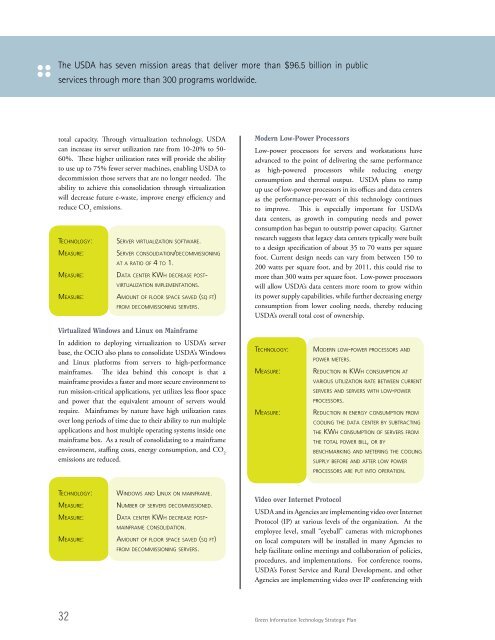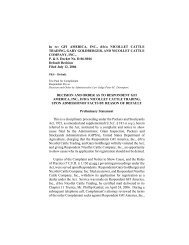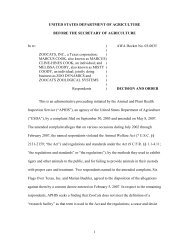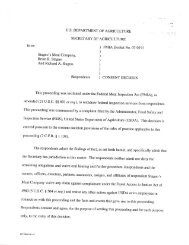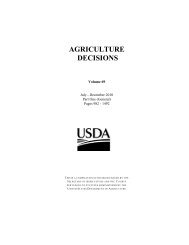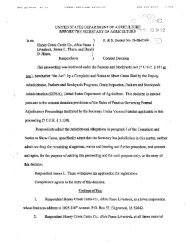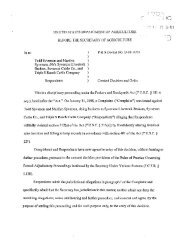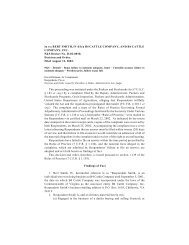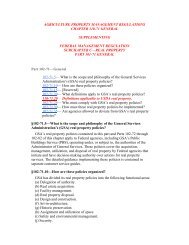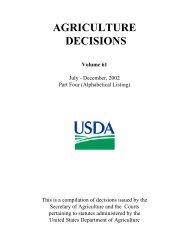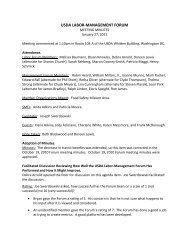Green Information Technology Strategic Plan - Departmental ...
Green Information Technology Strategic Plan - Departmental ...
Green Information Technology Strategic Plan - Departmental ...
You also want an ePaper? Increase the reach of your titles
YUMPU automatically turns print PDFs into web optimized ePapers that Google loves.
The USDA has seven mission areas that deliver more than $96.5 billion in public<br />
services through more than 300 programs worldwide.<br />
total capacity. Through virtualization technology, USDA<br />
can increase its server utilization rate from 10-20% to 50-<br />
60%. These higher utilization rates will provide the ability<br />
to use up to 75% fewer server machines, enabling USDA to<br />
decommission those servers that are no longer needed. The<br />
ability to achieve this consolidation through virtualization<br />
will decrease future e-waste, improve energy efficiency and<br />
reduce CO 2 emissions.<br />
te c h n o l o g y: server v i r t u a l i z a t i o n softWare.<br />
me a s u re: server c o n s o l i d a t i o n/d e c o m m i s s i o n i n g<br />
a t a r a t i o o f 4 to 1.<br />
me a s u re: da t a center kWh d e c re a s e postv<br />
i r t u a l i z a t i o n implementations.<br />
me a s u re: am o u n t o f f l o o r s p a c e saved (sq ft)<br />
f r o m d e c o m m i s s i o n i n g servers.<br />
Virtualized Windows and Linux on Mainframe<br />
In addition to deploying virtualization to USDA’s server<br />
base, the OCIO also plans to consolidate USDA’s Windows<br />
and Linux platforms from servers to high-performance<br />
mainframes. The idea behind this concept is that a<br />
mainframe provides a faster and more secure environment to<br />
run mission-critical applications, yet utilizes less floor space<br />
and power that the equivalent amount of servers would<br />
require. Mainframes by nature have high utilization rates<br />
over long periods of time due to their ability to run multiple<br />
applications and host multiple operating systems inside one<br />
mainframe box. As a result of consolidating to a mainframe<br />
environment, staffing costs, energy consumption, and CO 2<br />
emissions are reduced.<br />
te c h n o l o g y: Wi n d oW s a n d li n u x o n m a i n f r a m e.<br />
me a s u re: nu m b e r o f servers decommissioned.<br />
me a s u re: da t a center kWh d e c re a s e postm<br />
a i n f r a m e c o n s o l i d a t i o n.<br />
me a s u re: am o u n t o f f l o o r s p a c e saved (sq ft)<br />
f r o m d e c o m m i s s i o n i n g servers.<br />
32<br />
Modern Low-Power Processors<br />
Low-power processors for servers and workstations have<br />
advanced to the point of delivering the same performance<br />
as high-powered processors while reducing energy<br />
consumption and thermal output. USDA plans to ramp<br />
up use of low-power processors in its offices and data centers<br />
as the performance-per-watt of this technology continues<br />
to improve. This is especially important for USDA’s<br />
data centers, as growth in computing needs and power<br />
consumption has begun to outstrip power capacity. Gartner<br />
research suggests that legacy data centers typically were built<br />
to a design specification of about 35 to 70 watts per square<br />
foot. Current design needs can vary from between 150 to<br />
200 watts per square foot, and by 2011, this could rise to<br />
more than 300 watts per square foot. Low-power processors<br />
will allow USDA’s data centers more room to grow within<br />
its power supply capabilities, while further decreasing energy<br />
consumption from lower cooling needs, thereby reducing<br />
USDA’s overall total cost of ownership.<br />
te c h n o l o g y: mo d e r n l o W-poWer processors a n d<br />
poWer meters.<br />
me a s u re: re d u c t i o n in kWh c o n s u m p t i o n a t<br />
<strong>Green</strong> <strong>Information</strong> <strong>Technology</strong> <strong>Strategic</strong> <strong>Plan</strong><br />
v a r i o u s utilization r a t e betWeen c u r re n t<br />
servers a n d servers W i t h l o W-poWer<br />
processors.<br />
me a s u re: re d u c t i o n in energy c o n s u m p t i o n f r o m<br />
Video over Internet Protocol<br />
c o o l i n g t h e d a t a center by s u b t r a c t i n g<br />
t h e kWh c o n s u m p t i o n o f servers f r o m<br />
t h e total poWer bill, o r by<br />
b e n c h m a r k i n g a n d metering t h e c o o l i n g<br />
supply b e f o r e a n d after l o W poWer<br />
processors a re p u t i n t o operation.<br />
USDA and its Agencies are implementing video over Internet<br />
Protocol (IP) at various levels of the organization. At the<br />
employee level, small “eyeball” cameras with microphones<br />
on local computers will be installed in many Agencies to<br />
help facilitate online meetings and collaboration of policies,<br />
procedures, and implementations. For conference rooms,<br />
USDA’s Forest Service and Rural Development, and other<br />
Agencies are implementing video over IP conferencing with


